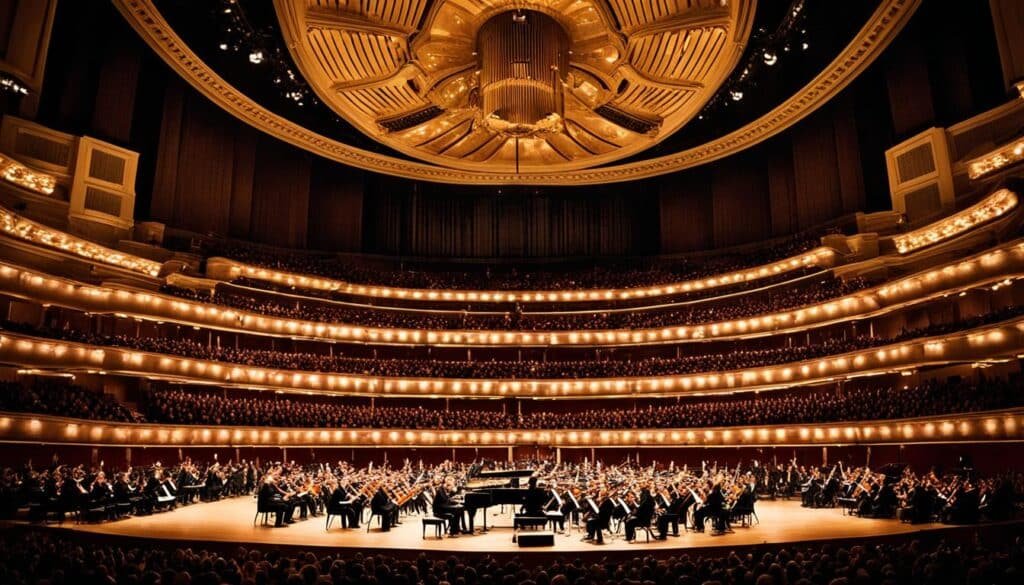Classical music is a highly respected and influential type of music around the world. It has a deep history and unique traits that have greatly influenced today’s music. The classical era, from 1730 to 1820, was a pivotal time. It brought forth some of the most famous composers in history, like Mozart, Bach, Beethoven, and Schubert.
This era saw classical music grow and develop its own special features. These features make it stand out from other music styles.
Key Takeaways
- The classical music period, spanning 1730-1820, was a transformative era that gave rise to legendary composers like Mozart, Bach, Beethoven, and Schubert.
- Classical music is defined by its emphasis on simplicity, accessibility, and the use of contrasting moods and emotions.
- Composers in the classical era often employed techniques like theme and variations, as well as distinct ornamentation such as trills and appoggiaturas.
- The rise of the piano as a prominent instrument was a key development during the classical period, shaping the evolution of the genre.
- Classical music’s enduring popularity and influence on modern music can be attributed to its unique characteristics and the timeless works created by its most celebrated composers.
The Classical Period: A Transformative Era
The classical music era lasted about a century from 1730 to 1820. It was a big change in music history. The Viennese school of classical music became the center of new music in Europe during this time.
Historical Context
The classical period in music came after the late Baroque era. It brought a new style and focus. Composers aimed for the ideals of Classical times, focusing on order and simplicity.
This movement was seen in music, art, architecture, and literature across Europe. It showed a cultural shift towards Classicism.
Emergence of Classicism
The classical music era brought a new way of making music. It was all about elegance, balance, and exploring music forms. Composers like Haydn, Mozart, and Beethoven shaped the classical period in music.
They made the music structures and techniques of the Baroque era better. The Viennese school of classical music was key in spreading this new style. Composers and musicians from Vienna became famous all over Europe.
Also Read: How Can You Start Your Career As A Session Musician?
“The classical period was a time of great musical innovation and refinement, as composers sought to capture the ideals of Classicism in their works.”
Simplicity: A Defining Trait

Classical music is known for its simplicity. This is a big change from the complex music of the Baroque era. Composers aimed to create simple, singable melodies that fit well with big groups. They drew inspiration from folk music.
The music’s texture became more homophonic. This means a clear melody with chords playing underneath. Composers focused more on melody and harmony. They used dynamics and phrasing to make the music more expressive.
Homophonic Textures
Classical music’s homophonic texture was a big change from Baroque music. It made the music simpler. This let composers focus on the melodic lines and harmonic progressions more.
Emphasis on Melody and Harmony
Unlike Baroque music, classical music focused more on singable melodies and harmonies. The accompaniment played a less important role. This made the music feel simpler.
Also Read: How To Make Money As A Musician?
“The classical period saw a shift towards a more homophonic texture, with a clear melody and supporting harmony, rather than the complex polyphony of the Baroque era.”
Accessibility and Public Concerts

During the classical period, classical music became more accessible to everyone. Before, it was mainly for the rich in private places. But, public concert halls started to appear in Europe, letting more people enjoy live music.
This change made classical music more for everyone, unlike the Baroque music before. It also brought in a new group of listeners. This led composers to write music for the public.
Concert halls were key to making classical music widely available. They gave musicians a place to perform for a wide audience. This made classical music more open to the public.
Also Read: What Are The Top Music Technology Degree Programs In The U.S?
| Era | Audience | Performance Venues |
|---|---|---|
| Baroque | Aristocratic | Private court settings |
| Classical | Middle class public | Public concert halls |
The move to public concerts changed how people enjoyed classical music. It made the music more for the people. Composers started writing music that the new audience would like, making classical music even more popular.
“The rise of public concert halls during the classical period was a pivotal moment in making classical music more accessible to the masses.”
Contrasting Moods and Emotions

Classical music is known for its ability to bring out many emotions and moods. Unlike the Baroque period, where one emotion often ruled, classical music mixes different feelings. This mix of emotions has made classical music popular and influential.
Shifting Dynamics and Tempos
Classical music often has sudden pauses and changes in mood. It can go from happy to sad quickly, with changes in volume. This mix of feelings was a key part of classical music, taking listeners on an emotional journey.
“Classical music has the power to transport listeners to a different emotional realm, where joy and sorrow coexist in a delicate balance, creating a truly mesmerizing and unforgettable experience.”
Being able to express many emotions made classical music popular in its time. Composers aimed to touch different feelings in their music. This approach captured audiences and left a mark on music history.
Also Read: Exploring Music Business Programs
Theme and Variations

Classical music is known for its “theme and variations” structure. A catchy theme is introduced and then changed in different ways. This makes the music interesting and easy to follow.
The main musical idea is the theme. It ties the whole piece together. Then, the composer changes the melody, harmony, and rhythm to create new versions. This shows their skill and creativity.
This method is more than just a technical trick. It’s a key part of classical music’s artistry. By using the theme and variations, composers can really show what a simple idea can become.
The theme comes back in different forms, making the music feel familiar. This structure helps tell a musical story. It keeps the audience engaged and connected to the music.
Using the theme and variations, composers could mix the new with the known. This made the music both structured and exciting. This approach has shaped classical music and changed how we experience art.
Also Read: Best Audio Engineering Courses And Universities
Classical Music Ornamentation

Classical music had less ornamentation than the Baroque period but still used many embellishments. Ornamentation in classical music made the music richer and more expressive.
Trills and Appoggiaturas
The trill was a common ornament, often used before a cadence. It was a quick switch between a note and the one above it, adding tension and excitement. Appoggiaturas were also used to add beauty with their decorative notes.
Vibrato and Instrumental Embellishments
Vibrato was a way to make music more expressive, used in woodwinds and piano. As the piano became more popular, composers found new ways to decorate their music. This showed off the piano’s unique sound.
“Ornamentation was an integral part of classical music, allowing composers to infuse their works with a range of emotions and textures.”
Techniques like trills and appoggiaturas and vibrato and embellishments shaped classical music’s unique sound. They made the music more expressive and memorable.
Classical Music Instruments

As classical music evolved, so did the instruments in orchestras. The woodwinds became more important and distinct. The harpsichord, once key in the Baroque era, was replaced by the piano. This change deeply influenced classical music’s future.
The Rise of the Piano
The piano could produce a wide range of sounds, from soft to loud. Composers started writing complex, virtuosic parts for it. This made the piano a key instrument in classical music.
Its versatility and expressiveness let composers try new things. This shaped the classical music genre.
The piano’s rise was a big change in music history. The harpsichord, once the main keyboard instrument, was left behind as the piano became more popular. This change showed how tastes and musical needs were evolving.
The piano’s rise led to amazing piano performances and a lot of new music. Composers used the piano’s unique sounds to create expressive music. This music highlighted the piano’s technical skill and emotional depth.
The growth of the piano was key to classical music’s unique sound. It showed how music tastes and concert culture were changing. This made the piano a central part of classical music.
Prominent Classical Composers
The classical period is linked to a group of famous classical music composers. They are the pillars of the genre, known as the Viennese School. This group includes Wolfgang Amadeus Mozart, Joseph Haydn, Ludwig van Beethoven, and Franz Schubert. They were either born in Vienna or worked there, making it the musical heart of Europe back then.
These famous classical composers shaped the classical style. Their music shows simplicity, easy listening, different moods, and theme and variations. Their impact is still felt today, keeping classical music popular and studied.
| Composer | Birth and Death | Notable Works |
|---|---|---|
| Wolfgang Amadeus Mozart | 1756 – 1791 | The Magic Flute, Symphony No. 40, Don Giovanni |
| Joseph Haydn | 1732 – 1809 | The Creation, The Seasons, String Quartets |
| Ludwig van Beethoven | 1770 – 1827 | Symphony No. 5, Moonlight Sonata, Fidelio |
| Franz Schubert | 1797 – 1828 | Unfinished Symphony, Ave Maria, Erlkönig |
“Music expresses that which cannot be put into words and that which cannot remain silent.”
– Victor Hugo
Conclusion
The classical period lasted about 90 years and changed music forever. It was known for its simple yet powerful music. This era focused on making music easy to understand and feel deeply.
It also brought new ways to structure music. Today, many artists and genres still look to classical music for inspiration. Many musicians learn from classical music’s rich traditions.
Classical music’s lasting impact shows the genius of its composers. They introduced elegant sounds and powerful emotions into music. Their work still moves both listeners and musicians.
Looking back, we see how classical music has shaped music today. It made music more accessible and emotionally rich. This era’s mix of simplicity and depth has inspired many to create new music.
FAQs
Q: What is classical music?
A: Classical music is a genre of music that has its roots in the traditions of Western classical music, typically spanning from the medieval period to the early 20th century. It is characterized by its complexity, richness, and adherence to established compositional forms.
Q: Who are some prominent composers of classical music?
A: Some of the most renowned classical composers include Johann Sebastian Bach, Ludwig van Beethoven, Wolfgang Amadeus Mozart, Frédéric Chopin, and Pyotr Ilyich Tchaikovsky, among many others.
Q: What are some key characteristics of Romantic music?
A: Romantic music is characterized by expressive melodies, rich harmonies, and a focus on emotional depth and personal expression. Composers like Chopin, Liszt, and Brahms were prominent figures in the Romantic period.
Q: What is the difference between baroque and classical music?
A: Baroque music, typified by composers like Bach and Vivaldi, is known for its ornate and elaborate compositions, while classical music, exemplified by Mozart and Haydn, is more structured, balanced, and symmetrical in form.
Q: What is a sonata in classical music?
A: A sonata is a musical composition typically consisting of three or four movements that showcase contrasting themes, forms, and keys. It is a common form in classical music compositions.
Q: What is a Nocturne in classical music?
A: A Nocturne is a musical composition inspired by the night, often characterized by its lyrical melodies, expressive qualities, and intimate atmosphere. Chopin is well-known for his beautiful Nocturnes.
Q: How does classical music differ from non-classical music?
A: Classical music is distinguished by its adherence to standardized forms, structured compositions, and historical significance, whereas non-classical music encompasses a wide range of genres, including popular, jazz, and world music, with more emphasis on improvisation and contemporary styles.




